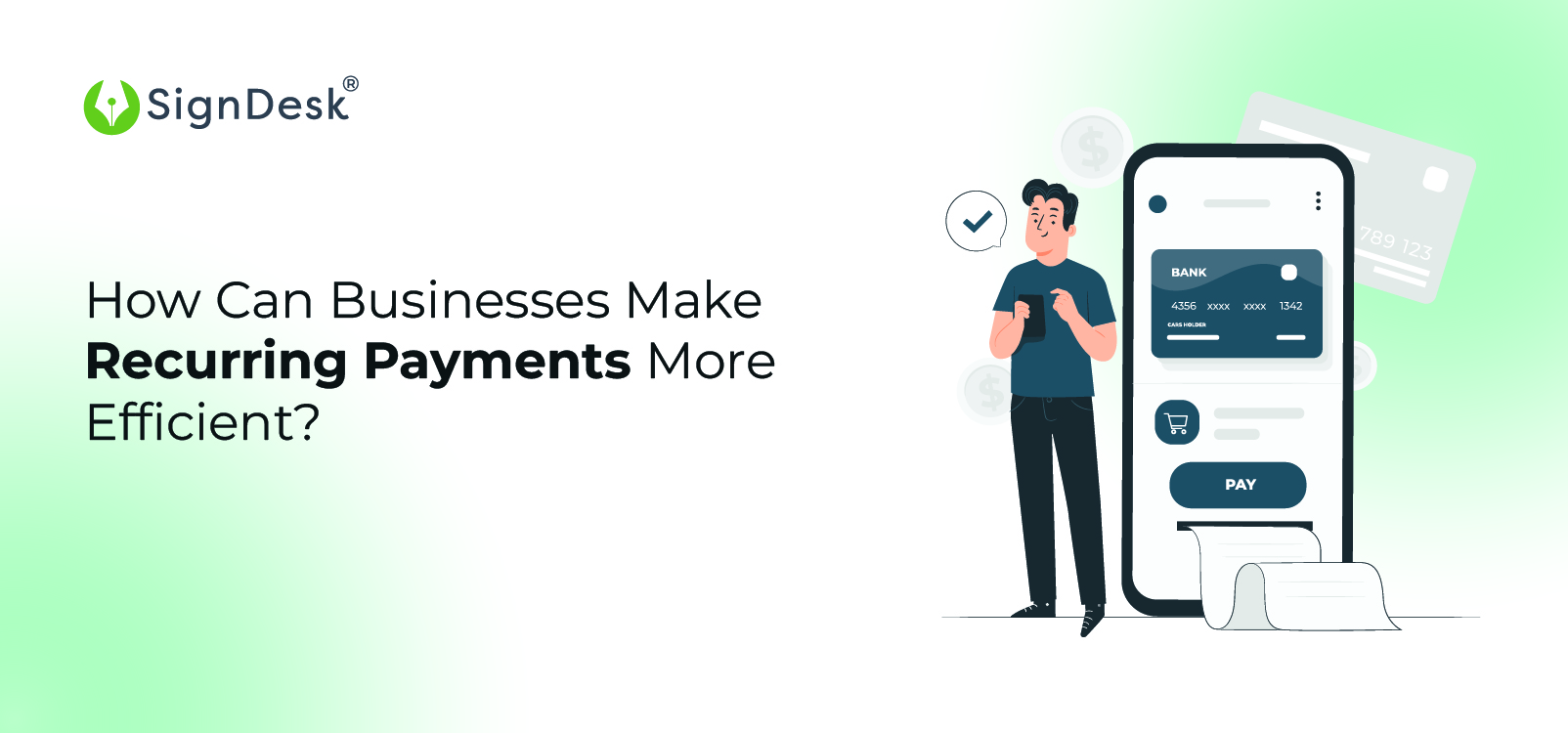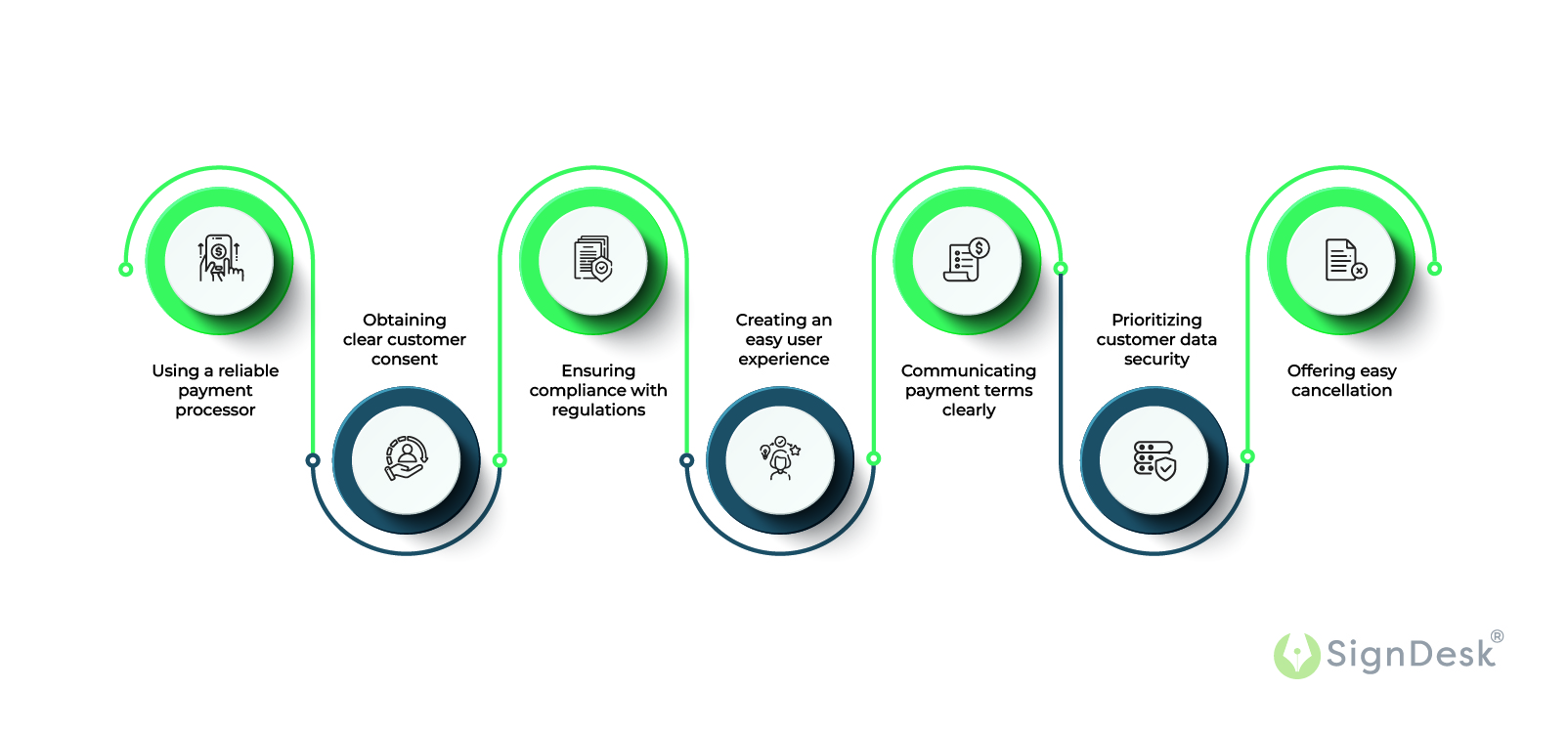
Recurring payment is a method of performing transactions that occur on a regular basis, at a set interval, such as monthly or annually. The amount for these transactions can be pre-determined or variable, as per the type of service the business provides.
Subscription-based services, utility bills, loan repayments & insurance premiums are common examples of recurring payments.
Recurring payment systems offer various advantages, including convenience, predictability, & cost savings, making them an essential part of personal & business financial management.
Automating plays an important role on this front, offering both the business & the customers several advantages. With automation, repeating payments are made automatically without the payer’s intervention each time a payment is due.
An Overview Of the Different Forms of Recurring Payment
Recurring payment comes in many forms, from monthly subscriptions to rent payments and loan installments. Broadly, there are two types of recurring payment models:
- Fixed Recurring Payment: This is a regular recurring payment model where the customer will be charged the same amount in every billing cycle.
This type of recurring payment typically applies to subscription payment models like magazine subscriptions & OTT platform/streaming service subscriptions that usually work on a monthly subscription payment system, gym memberships, professional association memberships, etc.
- Variable Recurring Payment: The amount charged in this recurring payment model may vary depending on how the customer uses the product or service.
The amount billed differs with each cycle, and the payment due is determined by the cost of services or products. Variable recurring payments are commonly used in pay-per-use payment models like SaaS payments and utility bills.
Common Use Cases For a Recurring Payment
Recurring payment has become commonplace in everyday scenarios, from subscription services to utility bill payments, owing to the convenience & efficiency they offer. Some common examples of recurring payments we come across on a day-to-day basis include the following:
- Rent payments: Paid for using a residential or commercial property.
- Utility payments: Payments made for ongoing services like electricity, Wi-Fi, gas & water.
- Subscription payments: Paid to access a product/service like newspapers, OTT, DTH, etc., continuously.
- Loan payments: Payments made regularly to repay housing loans, vehicle loans, mortgages, etc.
- Membership payments: Regular payments made to be part of a club or membership program.
- Insurance payments: Payments for ongoing insurance coverage, like health or auto insurance.
- SaaS payments: Recurring payments made for the use of software tools.
- Donations: Payments made to support charitable foundations or causes on a continuous basis.
How Do Businesses Accept Periodic Payments?
Recurring payment is an essential facet of many businesses, and several methods exist for accepting these payments. Some of the most common methods used by companies to accept payments that are periodic in nature are:
- Standing Instructions: The customer sets up a standing order with his bank, which transfers funds to the business’s account on a regular basis.
- E-Billing: Electronic billing allows businesses to send invoices at the end of each billing cycle to customers through text message/email. The customers pay the bill electronically using net banking, & credit/debit cards.
- Online Payment Processors: Businesses can use online payment processing services to set up recurring payments. Customers can authorize automatic recurring payments using their credit/debit card/ bank account.
- NACH eMandates: Electronic National Automated Clearing House is a centralized electronic payment system that facilitates interbank high-volume, low-value electronic transactions called e-Mandates that are repetitive in nature.
- Cash or Cheque Payments: Although less common nowadays, some businesses still accept cash or cheques for recurring payments. This method is frequently used by smaller firms or customers who prefer to pay in cash or by cheque.
Why Should Businesses Use eMandates For Payment Collection?
Electronic Mandate enables businesses to automate recurring payments, saving time & money on administrative costs. e-Mandate can help enterprises to increase customer retention & cash flow by providing a simple & convenient way for customers to authorize recurring payments.
e-Mandate is a powerful tool for businesses looking to improve their customer experience and streamline their payment collection process. NPCI indicates that the volume of transactions of NACH debits in January 2023 alone, is over 100 million. It is because e Mandates are fast, secure & reliable payment collection systems that simplify the process for businesses multifold.
With eMandate solutions like SignDesk that provide a secure & dependable platform for managing recurring payments, businesses can lower the risk of fraud & offer smooth customer journeys.
Different eMandate Types
eMandates enable businesses to offer their customers an easy & seamless payment experience. Depending on their requirements, businesses can choose from the following types of mandates for efficient collection of payments that are periodic in nature.
1. Aadhaar-Based eMandate
These mandates are registered using Aadhaar OTP authentication. The customer enters their registration information on the e-mandate provider’s portal & agrees to link their Aadhaar details.
The customer’s Aadhaar-registered mobile number is then sent an OTP, which is then used to authenticate the information provided by the customer.
Following authentication, the mandate details are sent to NPCI, the customer’s destination bank, and back to the e-mandate provider, who displays the status of the Aadhaar mandate to both the customer & the destination bank.
2. API eMandate
This type of mandate allows customers to authorize recurring payments in real-time & businesses can integrate this recurring payment collection process directly into their website or app.
With API eMandate, data is collected automatically by the e-Mandate provider & shared with the NPCI ONMAGS portal. The mandate details are then sent to the customer’s destination bank for confirmation, & once received, the customer is redirected to the destination bank, where they enter their debit card or net-banking information to authenticate the mandate.
3. Physical Mandates
A physical mandate is a method of authorizing recurring payments in which the customer signs a paper document, typically a form or a letter, authorizing the business to debit recurring payments from their bank account.
In this option, the customer fills out a form with their mandate information. This form is then submitted to the customer’s destination bank. E-mandate service providers use OCR-based document scanning to read data from mandate forms and send it to the NPCI and the destination bank for verification. Once the details are verified, the mandate is registered.
The Advantages Of Automating a Recurring Payment
Automating recurring payment hosts several advantages, & simplifies & streamlines the periodic debit & payment collection processes. Recurring payment automation saves time, reduces costs, and improves cash flow management by automating regular transactions.
Recurring payment automation, particularly through eMandates, has become increasingly popular over the years, offering significant benefits to both individuals & businesses.
- Enhances Convenience: Automating repeating payments eases the hassles of the process for the payers & businesses. Customers will not need to remember to make the payment or be present physically every time it is due. On the other hand, businesses do not have to chase after collecting customer payments with each cycle.
- Reduction In Expenses: By eliminating the need for manual payment processing & lowering the risk of payment delays or errors, automating recurring payments can reduce payment processing costs. This can result in significant cost savings for businesses as well as customers.
- Better Cash Flow Management: Recurring payment automation improves cash flow predictability for both payers and businesses. This aids in better budgeting & financial planning & prevents instances like cash flow shortages.
- Saves Time & Effort: Automating recurring payments eliminates the need for manual intervention each time a payment is due. This allows individuals & businesses to focus on more strategic activities while freeing time for other tasks.
- Increased Customer Retention: Automatic recurring payments can help businesses, especially those that offer subscription services, improve customer retention by ensuring that services are not interrupted due to missed payments.
Best Business Practices For Efficient Recurring Payment Management
Managing high volumes of recurring payments with different pricing models is often challenging for most businesses. Implementing the best practices to manage periodic payments helps businesses process them efficiently. Following the below practices helps organizations minimize the risk of processing errors, payment delays, and disputes.

Best Business Practices For Efficient Recurring Payment Management
- Use a reliable payment processing system: Businesses must ensure they use a secure payment processing system that safeguards their customers’ sensitive information & is compliant with industry & government regulations. SignDesk is a highly secure NPCI-compliant eMandate processing service that businesses can use to automate & streamline their payment collection.
- Obtain customer consent: Businesses must obtain clear & informed consent from their customers before setting up recurring payment cycles to ensure payment collection happens seamlessly.
- Ensure compliance with regulatory requirements: KYC verification is required by many industry standards for businesses operating in the cryptocurrency industry. These businesses can demonstrate their commitment to meeting them through KYC verification.
- Create an easy user experience: Businesses can gain improved reputation & customer trust by providing their customers with an intuitive & seamless recurring payment experience. On-time debit notifications, responsive customer support, easy cancellation policies, & well-defined payment dispute practices enhance the customer experience.
- Communicate payment terms clearly: One of the primary practices businesses must follow is to clearly communicate the recurring transaction’s terms, including payment frequency, debit amount, & the payment collection method they use, to their customers.
- Prioritize Customer Data Security: Meeting data security standards are among the top priorities for businesses to manage repeating payment cycles smoothly. Companies must exercise extreme caution when handling their customers’ personal data like bank account details, ID documents, etc.
- Offer easy cancellation: Companies must establish a clear & accessible recurring payment cancellation policy that allows customers to easily cancel their payment cycles without any hassle or penalty.
Switch to Seamless Payment Collection With SignDesk eNach
Automating repeating payments helps provide businesses & customers with a hassle-free payment experience.
SignDesk’s eNACH eMandate solution simplifies the recurring payment process by providing a secure & automatic recurring payment process with customizable payment frequencies, a user-friendly dashboard, & instant mandate authentication.
Making the shift to automated payment collection helps businesses optimize their financial management system. Book a free demo with us to see how SignDesk can add efficiency to your recurring payment processes.